Case study 2 : Fruitful cooperation at Chiclana and Almeria wastewater treatment plants
The second case-study taking place in Spain aims at producing bio-plastics (PHA- Polyhydroxyalkanoates), bio-methane and recovering nutrients and irrigation water.
Bio-plastics production will be through a two-stage anaerobic-photosynthetic system, using anaerobic pretreatment and High Rate Algae Pond (HRAP) systems. Project partner, iBET, is performing PHA production lab tests using 2 PBR (photo-bioreactors) that simulate El Toyo (Almeria) wastewater treatment ponds. The tests have been conducted with real fermented wastewater from AQUALIA and results indicate a successful enrichment of the reactors with PHA accumulating photosynthetic mixed cultures. Thus far, 15 – 20 % PHA accumulation has been obtained in the selector reactors, a value expected to rise in ongoing accumulation tests. The figure below shows a microscopic image of the photosynthetic cultures containing PHA granules.

Microscopic image of a photosynthetic mixed culture currently operated by iBET and fed with real fermented wastewater. a) Bright field; b) Fluorescence image of Nile blue staining indicating PHA granules.
Project partners AQUALIA and UVA work together to increase biogas production by at least 50%. They optimize physical and thermal pretreatment of microalgae. UVA has developed the design and flow chart of the biogas upgrading methodology using a biogas adsorption column of approx. 300 L and 32 m2 HRAP to treat a biogas flow of 400 L/h. AQUALIA is also evaluating different co-substrates at lab scale, for the anaerobic co-digestion process.
RECIRKU have elaborated the design and implementation steps for the evaporative systems, in Chiclana, to recover nutrients.

Evaporative system designed by RECIRKU
Project partners DTI and AU have been testing and developing media for the removal and re-use of nutrients. More than 10 media types have been tested with different potential coatings.
At the El Toyo (Almeria) wastewater treatment plant, the reclaimed water will be reused for irrigation. Project partner, FINT, have been working on the steps to carry out the smart irrigation system based on the creation of an internet-based system (‘’Internet of Things’’ approach). The crop will be grass/lawn.

















